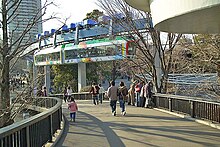Ueno Zoo monorail
The monorail Ueno Zoo ( Japanese. 上 野 動物園 モ ノ レ ー ル , Ueno dōbutsuen monorēru ), officially: Tōkyō-to kōtsū-kyoku Ueno kensui-sen ( 東京 都 交通局 上 野 懸垂 線 , dt. Ueno overhead railway line of the Tokyo city traffic line ) also: Ueno monorail ( 上 野 モ ノ レ ー ル , Ueno monorēru ) and Ueno Park monorail ( 上 野 公園 モ ノ レ ー ル , Ueno-kōen monorēru ), was a suspension railway in Tokyo . The operator was the Tokyo Prefecture Transportation Office .
The railway was opened on December 17, 1957 as a test route, but was used for passenger traffic . The construction was based on the Wuppertal suspension railway based on the system by Eugen Langen . With a length of 310 meters and two stops , however, the railway was relatively short and was not of great importance for transport. It connected two parts of the Ueno Zoo . At the end of 2019 the railway was closed because the necessary renovation would have been too expensive.
The driveway was made of precast concrete and steel parts. Initially, the top of the chassis beam was covered with asphalt , which was later replaced by concrete. In order to achieve a guide, guide wheels were attached to the sides of the bracket, and the chassis beam was curved inwards on the top. There were also two busbars there , which supplied the vehicle with 600 V direct current .
The only vehicle was 19 meters long, 1.68 meters wide, 2.46 meters high and weighed 6.5 tons. It was powered by four 7.5 kW motors that accelerated it up to 14 km / h.
